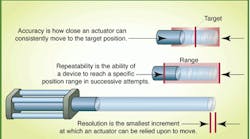Accuracy
Accuracy has two aspects. First is the accuracy of the actuator itself, determined by the moving element and its ability to travel in an ideal single-axis path or straight line. An inescapable truth: The motion provided by the actuator is only as true as its mechanical components. Actuator accuracy depends on the base or cylinder tube and the bearing or guidance system employed, such as ball bearings or slide bearings.
The second aspect is the actuator's ability to provide increments of precise motion along the working axis, which depends on leadscrew or ballscrew lead accuracy, feedback encoder or linear scale resolution, and controller precision.
Repeatability
Repeatability is the ability of a device to reach a specific location or position in successive attempts. Unlike accuracy, repeatability does not take into account the actuator's ability to travel an ideal axis. In real applications, an actuator often travels through a slightly bowed or twisting path due to the components used in its construction. Repeatability is influenced by the direction of approach to the target point.
For example, approaching the target from the same direction every time means that a unidirectional repeatability tolerance will apply. In contrast, approaching the same target from two different directions means that a bidirectional repeatability tolerance will apply. Bidirectional repeatability also includes the effects of leadscrew backlash, which in some cases will dramatically influence the repeatability tolerance. Note: An actuator may be highly repeatable without being highly accurate.
Resolution
Resolution refers to the smallest positional increment that can be asked of a motion system. Motors, encoders, controllers, and mechanical components act together to define system resolution. For example, a system using a stepper motor and micro stepper drive set (at 2,000 steps per revolution) and a five-turns-per-inch ballscrew gives 0.0001-in. resolution. Although it's possible to select systems with substantially better resolution, tighter resolution is not always practical. Why? Because mechanical limitations — such as friction and nut backlash in bidirectional moves — can render extremely small move commands ineffective.
Mounting
The way in which a linear motion system is mounted greatly affects the success or failure of linear motion applications. For example, actuators built using extruded aluminum profiles commonly exhibit conditions of bow and twist in addition to dimensional variances. If such an actuator is mounted rigidly to a known flat surface, the resulting move accuracy includes none of the bow and twist tolerance. Instead, it only includes the dimensional variance. This type of mount effectively straightens the actuator's extruded aluminum profile, though has zero effect on repeatability. Conversely, mounting such an actuator by a single point (or two points a substantial distance from one another) doesn't straighten the actuator: Moves typically follow the bow and twist of the extruded aluminum profile's base. In this scenario, accuracy is affected by bow and twist, but repeatability is unaffected.
Mounting a linear motion system to non-flat machinery members degrades performance as well. For example, if the actuator is rigidly mounted to a framework with an uneven surface, the actuator motion will bend to match the framework. In cases where accuracy and repeatability are required, an actuator's exact mounting position can be fine-tuned with shims or jackscrews.
This month's handy tips provided by Gary Rosengren, director of engineering, Tolomatic Inc., Hamel, Minn. For more information, visit www.tolomatic.com.

